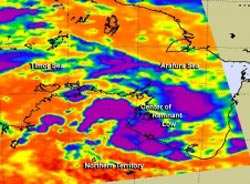NASA Sees Ex-Tropical Cyclone Alessia's Remnants Trying to Reorganize

On Nov. 25, NASA AIRS infrared data showed that System 02S's strongest thunderstorms (purple) with the potential for the heaviest rains stretched from Daly Waters in the north central part of the territory, east to Borroloola, south to Cape Crawford. <br>Image Credit: NASA JPL, Ed Olsen<br>
The Atmospheric Infrared Sounder or AIRS instrument captures infrared data and can provide scientists with temperature data on tropical cyclones. When NASA's Aqua satellite passed over the remnants of Tropical Cyclone Alessia on November 26 at 0447 UTC/Nov. 25 at 11:47 p.m. EST AIRS captured temperature data on the storm's clouds.
AIRS infrared data showed that the strongest thunderstorms with the coldest cloud top temperatures and the potential for the heaviest rains stretched from Daly Waters in the north central part of the territory, east to Borroloola, south to Cape Crawford.
The Australian Bureau of Meteorology issued a Coastal Waters Wind Warning for the southwest Gulf of Carpentaria waters at 11:00 p.m. CST local time on November 26, as the low was moving through the region. The remnants are now an elongated area of low pressure, or trough.
Forecasters at the Joint Typhoon Warning center noted that animated multispectral satellite imagery showed that the structure of the former tropical cyclone had improved as it moved over the western part of the Gulf of Carpentaria. Radar imagery from Gove, Australia indicated the banding of thunderstorms were fragmented as the low-level center was moving toward the northeastern coast of Australia's Northern Territory.
On November 26 (EST) at 10 a.m. EST, the remnant low was centered about 20 nautical miles/23 miles/37 km of 14.4 south and 136.8 east, about 60 nautical miles/69 miles/111 km south-southeast of Alyangula, Australia. The remnant low is expected to move slowly south before moving west on November 27 and 28 toward the Timor Sea.
The Joint Typhoon Warning Center gives the remnants a low chance for regeneration over the next couple of days.
Text credit: Rob Gutro
NASA's Goddard Space Flight Center
Media Contact
All latest news from the category: Earth Sciences
Earth Sciences (also referred to as Geosciences), which deals with basic issues surrounding our planet, plays a vital role in the area of energy and raw materials supply.
Earth Sciences comprises subjects such as geology, geography, geological informatics, paleontology, mineralogy, petrography, crystallography, geophysics, geodesy, glaciology, cartography, photogrammetry, meteorology and seismology, early-warning systems, earthquake research and polar research.
Newest articles

Properties of new materials for microchips
… can now be measured well. Reseachers of Delft University of Technology demonstrated measuring performance properties of ultrathin silicon membranes. Making ever smaller and more powerful chips requires new ultrathin…

Floating solar’s potential
… to support sustainable development by addressing climate, water, and energy goals holistically. A new study published this week in Nature Energy raises the potential for floating solar photovoltaics (FPV)…

Skyrmions move at record speeds
… a step towards the computing of the future. An international research team led by scientists from the CNRS1 has discovered that the magnetic nanobubbles2 known as skyrmions can be…




















